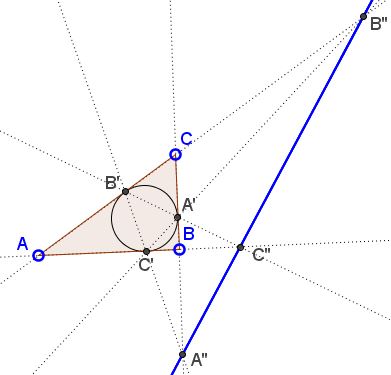Nobbs' Points, Gergonne Line
What are they?
A Mathematical Droodle
|Activities| |Contact| |Front page| |Contents| |Geometry|
Copyright © 1996-2018 Alexander BogomolnyNobbs' Points, Gergonne Line
The applet attempts to illustrate the following theorem:
Assume A', B', C' are the points of contact of the incircle of ΔABC: A' on side BC, etc. Denote the intersection of AB and A'B' as C'', that of AC and A'C' as B'', and let A'' be the intersection of BC and B'C'. Then points A'', B'', and C'' are collinear.

The points A'', B'', and C'' are known as Nobbs' points. The theorem tells us the Nobbs' points of a triangle are collinear. The line the points lie on was named the Gergonne line by Adrian Oldknow [Oldknow, pp. 324-325] after J. D. Gergonne. The reason for the name is as follows.
It is known that the lines AA', BB', and CC' meet at the Gergonne point Ge of ΔABC. Put another way, this means that two triangles ABC and A'B'C' are perspective in Ge. By Desargues' theorem, triangles perspective from a point are also perspective from a line. Thus the corresponding side lines of triangles ABC and A'B'C' cross in the points that belong to the same line. This is the Gergonne line of Oldknow.
I'll give an additional argument in support of that nomenclature: the Gergonne line is the polar of the Gergonne point Ge in the incircle of ΔABC. Indeed,
| A'B' | is the polar of | C, | |
| AB | is the polar of | C'. | Therefore, |
| C'' | is the pole of | CC', | by La Hire's theorem. |
Similarly, A'' is the pole of AA' and B'' is the pole of BB'. Since their polars AA', BB', and CC' are concurrent (in the Gergonne point Ge), the poles A'', B'', and C'' are collinear to a line (the Gergonne line, naturally.)
Note that if one of the triangles ABC and A'B'C' is equilateral, so is the other, and in this case the Gergonne line is the line at infinity.
Remark
ΔA'B'C' is known as the contact triangle (and also Gergonne triangle) of ΔABC. ΔABC is the tangent(ial) triangle of ΔA'B'C'.
(From a somewhat different perspective this same configuration is studied elsewhere. A more general statement is also available.)
References
- A. Oldknow, The Euler-Gergonne-Soddy Triangle of a Triangle, Amer Math Monthly, Vol. 103, No. 4 (Apr. 1996), 319-329
Poles and Polars
- Poles and Polars
- Brianchon's Theorem
- Complete Quadrilateral
- Harmonic Ratio
- Harmonic Ratio in Complex Domain
- Inversion
- Joachimsthal's Notations
- La Hire's Theorem
- La Hire's Theorem, a Variant
- La Hire's Theorem in Ellipse
- Nobbs' Points, Gergonne Line
- Polar Circle
- Pole and Polar with Respect to a Triangle
- Poles, Polars and Quadrilaterals
- Straight Edge Only Construction of Polar
- Tangents and Diagonals in Cyclic Quadrilateral
- Secant, Tangents and Orthogonality
- Poles, Polars and Orthogonal Circles
- Seven Problems in Equilateral Triangle, Solution to Problem 1
Symmedian
- All about Symmedians
- Symmedian and Antiparallel
- Symmedian and 2 Antiparallels
- Symmedian in a Right Triangle
- Nobbs' Points and Gergonne Line
- Three Tangents Theorem
- A Tangent in Concurrency
- Symmedian and the Tangents
- Ceva's Theorem
- Bride's Chair
- Star of David
- Concyclic Circumcenters: A Dynamic View
- Concyclic Circumcenters: A Sequel
- Steiner's Ratio Theorem
- Symmedian via Squares and a Circle
- Symmedian via Parallel Transversal and Two Circles
- Symmedian and the Simson
- Characterization of the Symmedian Point with Medians and Orthic Triangle
- A Special Triangle with a Line Through the Lemoine Point
Desargues' Theorem
- Desargues' Theorem
- 2N-Wing Butterfly Problem
- Cevian Triangle
- Do You Speak Mathematics?
- Desargues in the Bride's Chair (with Pythagoras)
- Menelaus From Ceva
- Monge from Desargues
- Monge via Desargues
- Nobbs' Points, Gergonne Line
- Soddy Circles and David Eppstein's Centers
- Pascal Lines: Steiner and Kirkman Theorems II
- Pole and Polar with Respect to a Triangle
- Desargues' Hexagon
- The Lepidoptera of the Circles
|Activities| |Contact| |Front page| |Contents| |Geometry|
Copyright © 1996-2018 Alexander Bogomolny73572914
